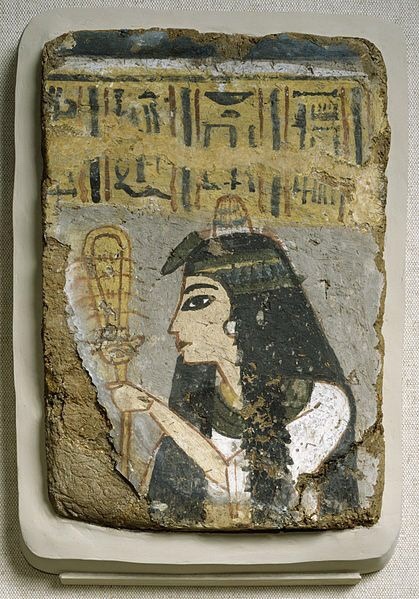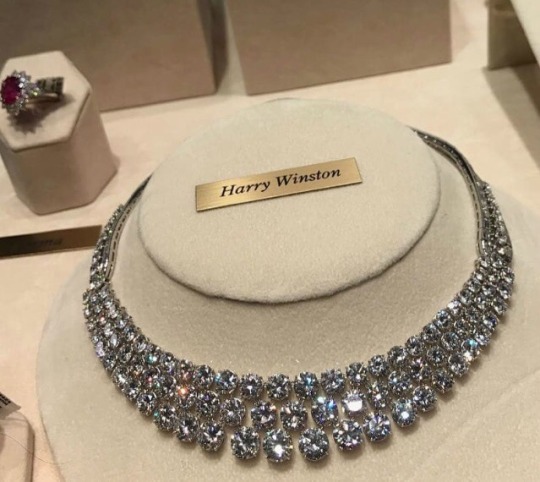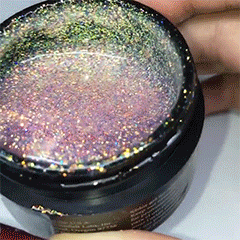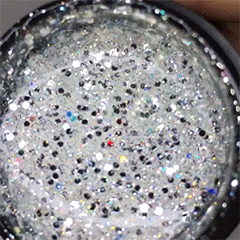Text
HISTORY OF MAKEUP
In order to understand the constantly changing trends in cosmetics, it is interesting to take a look at the evolution of makeup. Women and men have been wearing cosmetics for centuries, although the styles have certainly undergone some dramatic changes over time. Let’s take a look at how cosmetics evolved.
The earliest historical record of makeup comes from the 1st Dynasty of Egypt (c.3100-2907 BC). Tombs from this era have revealed unguent jars, which in later periods were scented. Unguent was a substance extensively used by men and women to keep their skin hydrated and supple and to avoid wrinkles from the dry heat. The women of Egypt also decorated their eyes by applying dark green color to the under lid and blackening the lashes and the upper lid with kohl, which was made from antimony (a metallic element) or soot. It is believed that the Jews adopted the use of makeup from the Egyptians, since references to the painting of faces appear in the New Testament section of the Bible.
Roman philosopher Plautus (254-184 BC) wrote, “A woman without paint is like food without salt.” Of course, Plautus was a dramatist, which would explain his preference for the look of a “painted woman” at that time.
Romans widely used cosmetics by the middle of the 1st century AD. Kohl was used for darkening eyelashes and eyelids, chalk was used for whitening the complexion, and rouge was worn on the cheek. Depilatories were utilized at that time and pumice was used for cleaning the teeth.
Women wore white lead and chalk on their faces in Greco-Roman society. Persian women used henna dyes to stain their hair and faces with the belief that these dyes enabled them to summon the majesty of the earth.
During the European middle ages, pale skin was a sign of wealth. Sixth century women sought drastic measures to achieve that look by bleeding themselves, although, in contrast, Spanish prostitutes wore pink makeup. Thirteenth century affluent women donned pink lipstick as proof they could afford synthetic makeup.
During the Italian Renaissance, lead pain was used to lighten the face, which was very damaging to the wearer. Aqua Toffana was a popular face powder named for its creator, Signora Toffana. Made from arsenic, Signora Toffana instructed her rich clientele to apply the makeup only when their husbands were around. It’s interesting to note that Tofana was executed some six hundred dead husbands later.
Cosmetics were seen as a health threat in Elizabethan England, although women wore egg whites over their faces for a glazed look.
During the reign of Charles II, heavy makeup began to surface as a means to contradict the pallor from being inside due to illness epidemics.
During the French Restoration in the 18th century, red rouge and lipstick were used to give the impression of a healthy, fun-loving spirit.
Eventually, people in other countries became repulsed by excessive makeup and claimed the “painted” French had something to hide.
During the Regency era, the most important item was rouge, which was used by most everyone. At that time, eyebrows were blackened and hair was dyed. To prevent a low hairline, a forehead bandage dipped in vinegar in which cats dung had been steeped was worn. Most of the country dwellers’ makeup recipes made use of herbs, flowers, fat, brandy, vegetables, spring water and, of course, crushed strawberries. During this era, white skin signified a life of leisure while skin exposed to the sun indicated a life of outdoor labor. In order to maintain a pale complexion, women wore bonnets, carried parasols, and covered all visible parts of their bodies with whiteners and blemish removers. Unfortunately, more than a few of these remedies were lethal.
The most dangerous beauty aids during this time were white lead and
mercury. They not only eventually ruined the skin but also caused hair loss, stomach problems, the shakes, and could even cause death. Although these dangers became known through the death of courtesan Kitty Fisher, the majority of women continued to use these deadly whiteners.
During the 1800’s, women would use belladonna to make their eyes appear more luminous, even though they were aware it was poisonous. Many cosmetics were made by local pharmacists, known as apothecaries in England, and common ingredients included mercury and nitric acid. Hair dye was made from coal tar, which is now illegal in America.
It might interest you to know that men wore makeup until the 1850’s. George IV spent a fortune on cold cream, powders, pastes, and scents. However, not all men wore makeup, as many looked upon a man with rouged cheeks as a dandy.
Here are some beauty-tip recipes utilized during the late 1800’s:
*For freckle removal: bruise and squeeze the juice out of chick-weed, add three times its quantity of soft water, then bathe the skin for five to ten minutes morning and evening.
*As a wash for the complexion: one teaspoon of flour of sulphur and a wine glassful of lime water, well shaken and mixed with half a wine-glass of glycerine and a wine-glass of rose-water. Rub on the face every night before going to bed.
*To keep hair from turning gray: four ounces of hulls of butternuts were infused with a quart of water, to which half an ounce of copperas was added. This was to be applied with a soft brush every two to three days.
*For wrinkle removal: melt one ounce of white wax, add two ounces of juice of lily-bulbs, two ounces of honey, two drams of rose-water, and a drop or two of ottar of roses and use twice a day.
Victorians abhorred makeup and associated its use with prostitutes and actresses (many considered them one and the same). Any visible hint of tampering with one’s natural color would be looked upon with disdain. At that time, a respectable woman would use home-prepared face masks, most of which were based on foods such as oatmeal, honey, and egg yolk. For cleansing, rosewater or scented vinegars were used. As a beauty regimen, a woman would pluck her eyebrows, massage castor oil into her eyelashes, use rice powder to dust her nose, and buff her nails to a shine. Lipstick was not used, but clear pomade would be applied to add sheen. However some of these products contained a dye to discretely enhance natural lip color. For a healthy look, red beet juice would be rubbed into the cheeks, or the cheeks would be pinched (out of sight, of course). For bright eyes, a drop of lemon juice in each eye would do the trick. When makeup began to resurface, full makeup was still seen as sinful, although natural tones were accepted to give a healthy, pink-cheek look.
The real evolution actually began during the 1910’s. By then, women made their own form of mascara by adding hot beads of wax to the tips of their eyelashes. Some women would use petroleum jelly for this purpose. The first mascara formulated was named after Mabel, the sister of its creator, T. L. Williams, who utilized this method. This mascara is known today as Maybelline. In 1914, Max Factor introduced his pancake makeup. Vogue featured Turkish women using henna to outline their eyes, and the movie industry immediately took interest. This technique made the eyes look larger, and the word “vamp” became associated with these women, vamp being short for vampire.
During this decade, the first pressed powders were introduced which included a mirror and puff for touchups. Pressed powder blush followed soon after. The lipstick metal case, invented by Maurice Levy, became popular. Also, during this time, lipstick was tattooed onto the lips by George Burchett, who was also known as the “Beauty Doctor”. This method did not always work, and you can imagine the terrible consequences.
The earliest version of an acid peel was utilized at this time, which was a combination of acid and electric currents applied to the skin. Also, a needle would be used to insert paraffin to the eye area and cheeks, although this, too, was not very successful. Nivea cream made its appearance in Germany, and companies, in order to compete, began creating creams consisting of Vaseline mixed with fragrance.
To help with sagging jowls and double-chins, women could purchase for wear a weird-looking contraption with chin straps, which obviously did not work.
However, the Victorian look remained in fashion until mass makeup marketing came about during the 1920’s. The newly emancipated woman of America began to display her independence by free use of red lipstick, which was often scented with cherry. By the late ’20’s, visible makeup was considered a must by rural women but was still frowned upon by the country girls. During this decade, lip gloss was introduced by Max Factor. New shades of red lipstick were developed, although were soap-based and very drying. The first eyelash curler came on the scene, called Kurlash. Even though it was expensive and difficult to use, this did not detract from its popularity. Mascara in cake and cream form was extremely vogue.
From the 1930’s through the 1950’s, various movie stars proved to be the models for current trends in makeup. Remember Audrey Hepburn’s deeply outlined cat eyes? With the ’60’s and the hippies came a more liberated makeup look, from white lips and Egyptian-lined eyes to painted images on faces. Heavily lined eyes continued through the ’70’s and ’80’s with a wide range of eye shadow colors. Today’s trend seems to have reverted to the more natural look with a blending of styles from the past.
In today’s world, a woman has literally hundreds of cosmetics to choose from, with a wide variety of colors and uses. For a younger look, the options available are as simple as skin hydrators and rejuvenators, advancing to chemical skin peels, the now-popular Botox, collagen injections, and ending with the more-drastic surgical facelift.
It is important to reflect on one’s inner beauty as the real beauty of a woman. Outer beauty will not remain forever, no matter what drastic measures are taken. We have all heard the saying, “The eyes are the windows to the soul”. Look into your own orbits, take stock of the woman inside, and be happy with who you are. This will reflect on your outlook on life, which will send a message to others, and will be returned to you through their reactions to the beautiful you.
0 notes
Text
What is makeup?
As the title suggests, we would be talking on the very basic and stupid looking question,”What is makeup?. As funny and dumb as it sounds many people would rather laugh and say,” ah come on we do know what makeup is”. But do we know how, when and where did it originate? and why did they use makeup for? Let us talk on it, starting way back to the time when people actually invented makeup.
First let”s see what wikipedia has to say about it
make-up
ˈmeɪkʌp/
noun
noun: makeup
Cosmetics such as lipstick or powder applied to the face, used to enhance or alter the appearance
It says that it is the enhancement or alteration of the appearance with the help of cosmetics, which ironically is true. But there is a lot more to the meaning of the term beyond wikipedia and the instagramy makeup tutorials we see. Makeup according to me is the trick to look flawless, more like hiding the flaws which make you feel less confident while facing people. In this age when everyone wants to look beautiful it has become more of a necessity than luxury. Talking of luxury let me throw light on the original purpose of why makeup was used when it was first invented or introduced.Let us go back in time like some hundred years into the Egyptian era.
Call it vanity, if you must, but spending quality time in front of a mirror is a daily ritual millions of women can’t do without, whether they’re preparing for an average day at work, a big event, or a date with that special someone. It all goes back to the ancient Egyptians, who were the first women to wear makeup.
In a way, the basic motive back then was the same as it is today- just like modern day supermodels, the well-to-do women of ancient Egypt wanted to look their best and saw the careful application of face-paint as a means to that end.

But unlike today’s modern women, they weren’t trying to impress that cute guy at work or the guy at that important job interview. And the Egyptian women weren’t trying to catch the eye of the burly construction foreman working on the pyramids or the local pharoah either. Their sights were aimed a little higher. They were trying to impress the gods.
Archeological evidence shows the Egyptian ladies were dolling themselves up as early as 4000B.C. This was mainly, or at least in good part, to please the gods, as the women felt their appearance was directly related to their spiritual worth. So the Egyptians created the first cosmetics (no word on whether they received makeovers at malls along the Nile.
They applied eye makeup called mesdement (from the ancient Egyptian word <>msdmt) a mixture of copper and lead ore, around their eyes. Green shades went on the lower eyelids; black and dark gray were applied to the lashes and upper eyelids. Dark colors were said to ward off “evil eyes”.
To complete the ornate look around the eyes, they added almond shapes of dark-colored powder (later called kohl) that might have been a combination of ingredients such as burnt almonds, oxidized copper, copper ores, lead, ash, and ochre . Kohl was believed to have medicinal benefits as well.
Egyptian women put a mixture of red clay or ochre and water or animal fat on their cheeks and lips- the first blush and lipstick- and applied henna to their nails. When it came time to remove all of these cosmetics at the end of the day, they used a type of soap made from vegetable and animal oils and perfumes.
Although these earliest beauty products the ladies put on were originally intended to please the gods, it doesn’t take much imagination to consider the effect these doses of makeup had on the local Egyptian men (probably similar to the first cave girl who realized the effect her short animal skin dress had on the cave men and boys she walked by).
The connection between beauty and spirituality remained for centuries, until the Romans gained power. The Romans adopted many of the Egyptians’ cosmetic formulas, but their primary motive was to improve their appearance for each other (especially the Roman men). The “god factor” did not enter into it.

And ever since then, from the earliest Egyptian women and the earliest Roman women to Angelina Jolie and Jennifer Aniston to the high-school cheerleader to the teenage girl working her first job at the mall, the more things change the more things stay the same. As the sun rises in the east and sets in the west, the sight of a beautiful woman or girl turns heads, captures attention, and causes a great effect.
This was all about who invented it first and why was it used. And we can say that makeup did evolve and no longer is used to ward off evil or please gods but bring in confidence and look good.
0 notes
Text
Hello!
This happens to be my first post here and so i would start it with some info about myself. I am a simple human trying hard to fit into this world. I love reading, writing and creating stuff [ well thats what i call it].
I love makeup and experimenting with it. I would be writing and posting a lot about beauty and skincare and how it can be enhanced sitting right at home. So join me on this journey😊
0 notes








